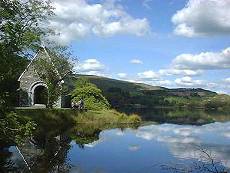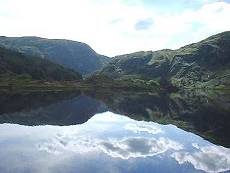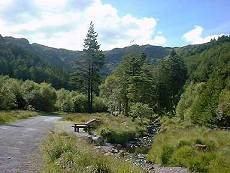|
|
|
|
|
|
 |
Gougane Barra
|
|
Pleasant scenic inland drive to
the monastery of St Finbarr the patron saint of
Cork. |
|
Route
Details : 88Km (55miles) |
|
Road Type : Normal |
|
View More Pictures... |
|
|
-
At the outskirts of Dunmanway, take the R587 towards
Macroom.
-
About 5 kilometers from Dunmanway the road curves to
the right and a smaller road goes straight ahead. choose this
one; it is signposted to Inchigeela.
-
When this road joins the R585, go left.
-
Then take the first road on your right - signpost says
"Grotto" and "Togher". These roads are through rough
countryside.
-
At the edge of Inchigeela Village go left on road
signposted "South Lake Road".
|
 |
 |
-
When you have traveled a mile on
that road, you will come to a Mass Rock on your left. Mass was
secretly celebrated here, whenever possible during the era of the
Penal Laws, which outlawed the Catholic religion (latter half of
17th and most of the 18th centuries).
-
A little further on is Cooregrenane
Wood. There is a pleasant path through the woods to a vista
point, but it is not for the faint-hearted, as it becomes very steep
as it climbs
-
The road continues along the southern
shore of Lough Allua, beneath the foothills of the Sheehy Mountains.
This lake is noted for pike fishing.
|
-
As you drive on you are entering a Gaeltacht (Irish
speaking) area.
-
When this lake road rejoins the main road (R584) go
left. A few miles further on you come to a junction where a
sign-post indicates the road to Gougane Barra on your right.
-
There is an air of peace and tranquility about Gougane
Barra. Against a backdrop of rugged hills, on a little island in
the lake is the site of the sixth century hermitage of St. Finbarr (Barra
in Irish) founder, and first Bishop of Cork.
|
 |
 |
-
This island is linked to the mainland
by a causeway. The little chapel on the island was built at
the end of the nineteenth century. Its design is said to have
been influenced Cormac's chapel in Cashel, Co. Tipperary, which
dated from the eleventh century.
-
About the end of the seventeenth
century a Fr. Denis O'Mahony became a hermit on the island and
Gougane Barra became a place of pilgrimage.
|
-
The ruins on the island are from that period. The
cross in the centre is said to stand where St. Finbarr's cell was, in
the sixth century.
-
As you come back to the mainland, the tomb you see to
your left is the resting place of Fr. O'Mahony.
-
In the little graveyard beside it is the grave of
Timothy O'Leary, the Tailor who was the subject of Eric Cross's book
"The Tailor and Ansty" - a book which caused a minor furore on its
publication. His headstone has the inscription " A star danced
and under that I was born".
|
 |
-
As you drive towards the National Park
is an unusual, prize-winning structure - a toilet.
-
The National Park covers several
hundred acres stretching from the lake-side into the mountain.
There is a nice circular drive through the Park; there are numerous
picnic tables, several well-marked nature trails. As you begin
your descent note the little sign "An Loai" on your left. That
little stream is the River Lee which enters the sea in Cork Habour.
Its source is a little bit further up the mountain.
-
When you rejoin the main road (R584),
go left. The village of Beal Atha 'n ghaorthaigh (Ballingeary)
is a centre where students come in large numbers during the Summer
to perfect the knowledge of Irish.
-
At Inchigeela take a right to return
to Dunmanway.
|
|
|
|
|
|
Copyright © MC. All rights reserved
Terms Of Use |